Circuit Maximus
If you think circuit-training is for novices, you’ll change your tune after doing this 7-day full-body program.

If you think circuit-training is for novices, you’ll change your tune after doing this 7-day full-body program.

Remember the Nautilus machine circuits they used to take beginners through at the gym back in the day? The ones where the machines were lined up in a perfect row and people could go through the routine at a nice, leisurely pace?
Well, the workouts I’m about to show you, while similar in name, are nothing like that.
Circuit training may not sound like the most hardcore program out there, but leave it to me to turn it up a few notches with the help of cutting-edge science, hard work and a little creativity.
My full-body circuits are intense and demanding and done on consecutive days, utilizing a variety of equipment through the course of a week. I’ll work some machines in, sure, but you’ll also be doing circuits with barbells, dumbbells, cables, bands, and bodyweight moves.
These aren’t your father’s Nautilus circuits. This is seven days of fast-paced and intense full-body training that will promote gains in muscle mass and strength while also enhancing your cardio and recovery. Don’t let the name – circuit training – fool you.
Circuit training refers to moving from one exercise for a muscle group to another exercise for a different muscle group, and repeating in this fashion until you’ve completed one set of one exercise for all major muscle groups. This cycle can then be repeated as many times as you like.
And while you may think this style of workout would leave muscle groups with too much rest, this isn’t the case at all. There’s no downfall here in terms of training stimulus, only benefit.
Think about it. If you start with one exercise for chest (say, bench press) and go to all-out failure, you allow the pecs to rest while you hit a set for back, legs, shoulders, traps, calves, triceps, biceps, forearms, and abs. But your body didn't get a rest, just your chest did. Now you can hit bench press again and likely get about the same number of reps as the first set.
In essence, you’re doing more work with this technique, because you’re able to maintain your rep counts with the same weight. And doing more work can lead to better gains in muscle strength, and even muscle mass.
When used for short periods of time, such as a week, circuit training can be repeated frequently with great results. I often come back to it every 6-12 weeks in my own program.
Another benefit to circuits is that, because you move from one muscle group to another, you don't fatigue as fast and can move through all exercises with little to no rest. This constant movement keeps your metabolic rate up and introduces a significant cardiovascular component to the training.
In my Circuit Maximus program, you’ll start each workout (and each circuit) with a chest exercise. Then, you’ll immediately move to a back exercise, then legs, shoulders, traps, calves, triceps, biceps, forearms, and finish with abs.
Typically, I’ll have you go through each circuit 3-4 times, though beginners can limit the volume to 1-2 circuits per workout and highly advanced individuals can do up to five rounds.
This will be the order of exercises:
The nice thing about my style of circuit training is that you don't have to repeat the same exercise each time you come back to that muscle group. If you repeat the circuit three times, you can certainly do bench press in all three rounds. Or, you can do three different exercises that hit different areas of the chest (ie, a flat-bench press, an incline press and a decline press). Or, you can do three different exercises that hit the same area of the muscle group (ie, three incline moves – say, an incline press, a feet-elevated push-up and an incline dumbbell flye).
Below are my seven workouts in the Circuit Maximus program. They all follow the circuit-training concept, but they don’t all look the same – far from it. Each circuit features a different training technique, in addition to circuit-training being its own unique technique.
You’ll see workouts that alter rep ranges and place different focus on muscle groups; light work using only single-joint exercises, plus heavy weights and compound moves; light but explosive “power” training; and even a routine consisting of “mini-circuits.”
As I mentioned before, you’ve never seen circuits like these. Over the course of a week’s worth of workouts, you’ll be keeping intensity, metabolic rate and muscle-building potential high while also enhancing power, strength, endurance and cardiovascular capacity.
I designed the workouts to be done on seven consecutive days, but if you're not as advanced as me you certainly please feel free to insert rest days. If you prefer to train three days a week (Monday, Wednesday and Friday), that will work fine with this program. Just do Workouts 1, 2 and 3 on Monday, Wednesday and Friday, then Workouts 4, 5 and 6 the following week, then Workout 7 the next Monday. You can start your next program two days later, on Wednesday. If you train four days a week, you can do this program Monday, Tuesday, Thursday and Friday. Make this program your own.
(To download a workout to your mobile device, click on the workout title – Workout 1, Workout 2, etc.)
In this workout, I stuck to dumbbells to maintain one station in the gym, but feel free to use any version you prefer. Cycle through in this order for 3-4 circuits without taking any rest other than to move to the next exercise and weight.
In this workout, we'll do a version of Hundreds training that I call my "Hundreds Circuit." Here, the goal is to complete 100 reps of each of the 10 exercises – but not 100 reps in a row. Instead, they'll be done in circuit fashion.
For each exercise, pick a weight that's around 30%-50% of your 10-rep max (10RM). Using triceps pressdowns as an example, say on circuit 1 you complete 38 reps. Then, after doing all the nine other exercises, you complete 37 reps of triceps pressdowns on circuit 2. That means that on circuit 3, you only need to complete 25 reps till you're done. But feel free to go past 25 reps if you can and take it to muscle failure.
If after three full circuits you haven't completed 100 reps on all exercises, only do the exercises that have reps left to complete on any further circuits. Because you're required to complete all 100 reps with the same exercises for this workout, I suggest sticking in one spot again. I recommend the cable crossover or dual cable station; cables work great with the super high reps required in this workout.
But feel free to do any version of each exercise you want. And if the gym gets too busy, you can change up exercises for each muscle group if need be. For example, with triceps again, if you lose the triceps pressdown station after circuit 1, you can move to lying triceps extensions in successive circuits. Competing 100 reps per muscle group is more important than doing 100 reps of a particular exercise.
This workout is my "30 Circuit," which involves 30 exercises and 30 reps total per muscle group. No stopping! Here's how it breaks down:
Since the last two workouts kept exercises selection to a minimum, here we get plenty of variety in both exercises and rep ranges.
*One other note: In this workout, I included the cable step-up (Circuit 2, third exercise). I show you why doing step-ups with cables or bands works a bit better then free weights.
It only took me 45 minutes to complete this workout – just goes to show that training doesn't have to take all day.
Jim's 30 Circuit
Circuit 1 (15 reps per exercise):
Circuit 2 (10 reps per exercise):
Circuit 3 (5 reps per exercise):
Circuit 1 photos:
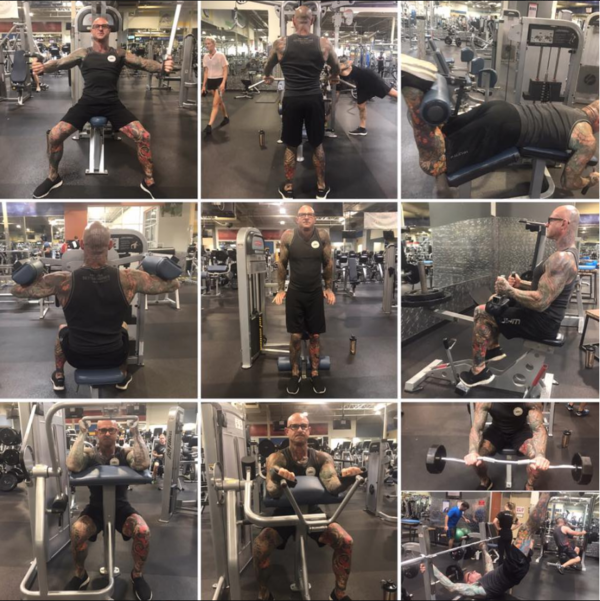
Circuit 2 photos:
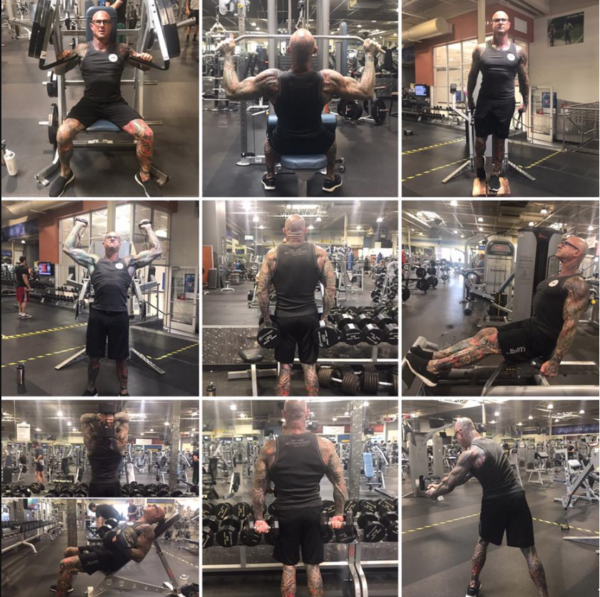
Circuit 3 photos:
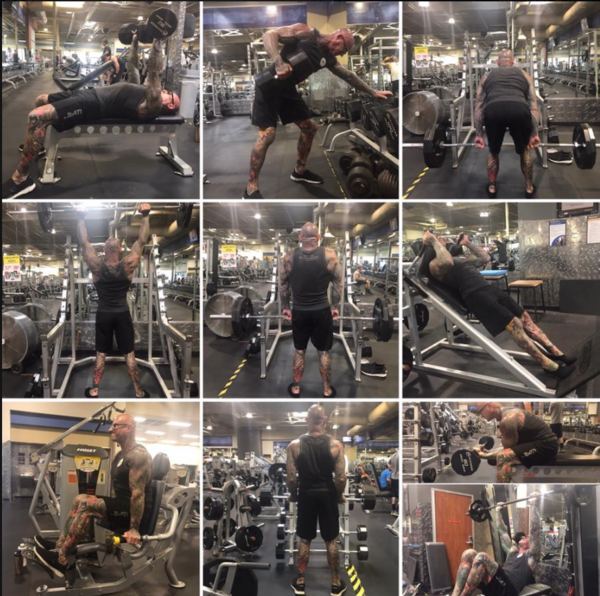
This is what I call my "Power Circuit." Here's how it works: You have 15 seconds per exercise to complete as many reps as possible using a weight that allows you to complete about 10 normal-paced reps. Once the 15 seconds are up, you move to the next exercise. Once you complete all 10 exercises, start back from the top and continue in that order until you complete 30 reps per exercise.
Ideally, you should stick to the same exercise for each muscle group. I'm giving you my version (below) that's done with a barbell, a power rack, and an adjustable bench. Use any version of each exercise, or any exercise for that muscle group, that you prefer.
Here's a video of me explaining my Power Circuit concept:
This workout employs my "Mini Circuits" technique. With this concept, you break the body up into 3-4 muscle groups at a time, then you do all 3 sets for that group of exercises before moving to the next group of exercises. There are several benefits to this tactic. One benefit is that you don't have to wait so long before performing an exercise again. So less rest. That's a benefit when the body has been previously getting more rest. Another benefit is that it prevents smaller muscle groups from limiting strength on exercises for major muscle groups. For example, if you did today's workout as a straight circuit, doing triceps pressdowns in circuit 1 may limit your strength on the chest press in circuit 2 and 3.
Mini Circuit 1 (6-8 reps x 3 sets):
Mini Circuit 2 (12-15 reps x 3 sets):
Mini Circuit 3 (16-20 reps x 3 sets):
Mini Circuit 1 photos:
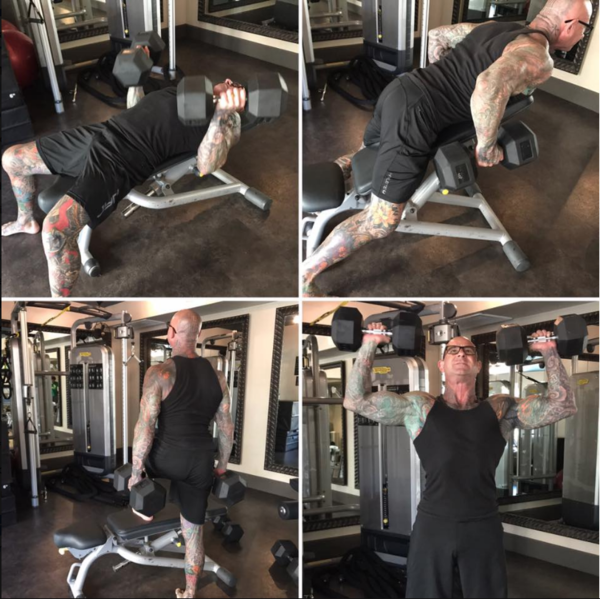
Mini Circuit 2 photos:
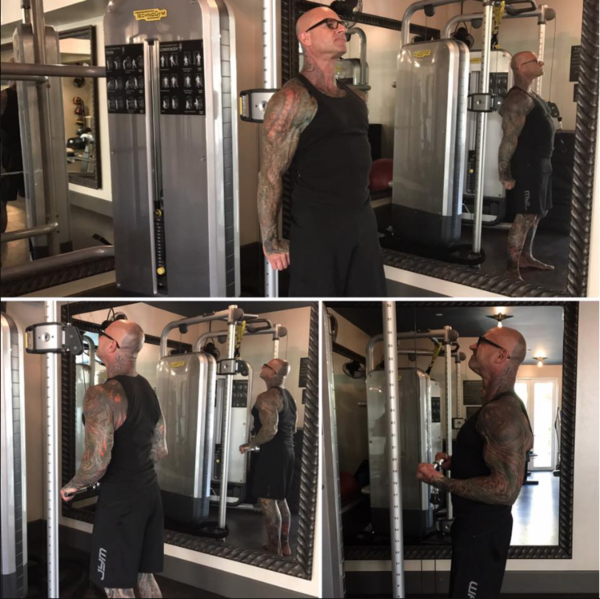
Mini Circuit 3 photos:
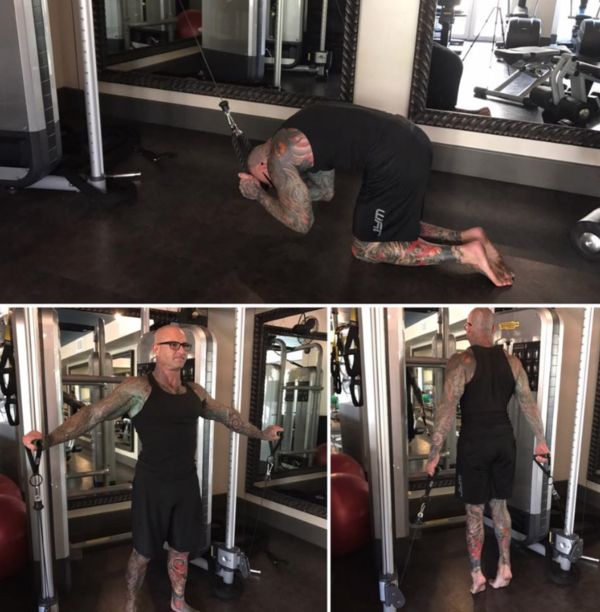
I call this my "Back and Forth Circuit" – not to be confused with my Back and Fourth training program. It's a similar concept but MUCH different with circuits. You'll be doing three different circuits in this workout (circuit 1, circuit 2, circuit 3).
The order of exercises in circuit 1 goes: chest, back, legs, shoulders, traps, calves, triceps, biceps, forearms and abs. Then, in circuit 2, you go in the opposite order: abs, forearms, biceps, triceps, calves, traps, shoulders, legs, back and chest. Then, in the third and final circuit, you go back down in the original order: chest, back, legs, shoulders, traps, triceps, biceps, forearms, and abs.
On each circuit, you'll do a different exercise for each muscle group and a different rep range. Circuit 1, you'll do each exercise for 6-8 reps to failure. I suggest you focus on multijoint moves here. In circuit 2, pick either an exercise that hits a different area of the target muscle from the exercise in circuit 1, or a single-joint movement. In circuit 2, reps will be 12-15 to failure. Then, in circuit 3, reps go up to 16-20.
Through the three circuits, you get variety in rep ranges and weight, variety in exercise selection, and variety in exercise order. That's manipulating 3 of the 5 major variables you can change in a workout. And as Meatloaf sang, “3 out of 5 ain't bad”… or was that 2 out of 3???
Below are the exercises I chose to do. Pick any moves you like, but use my exercise types as a template. There's a reason to my exercise selection, since smaller muscle groups get trained prior to larger ones in circuit 2.
Circuit 1 (6-8 reps):
Circuit 2 (12-15 reps):
Circuit 3 (16-20 reps):
Circuit 1 photos:
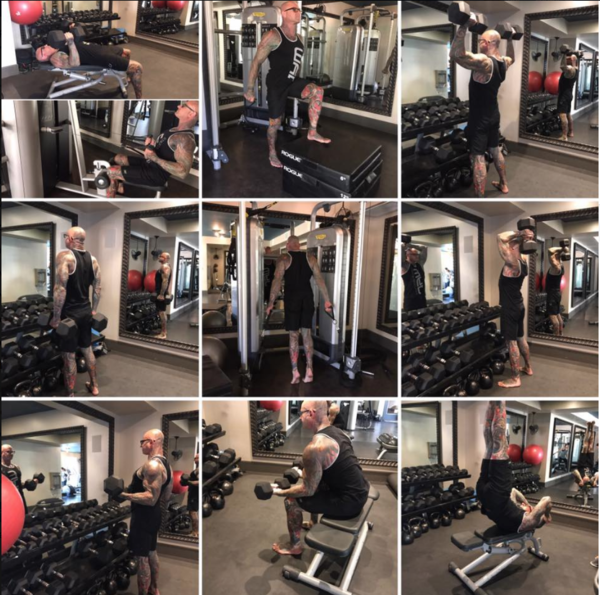
Circuit 2 photos:
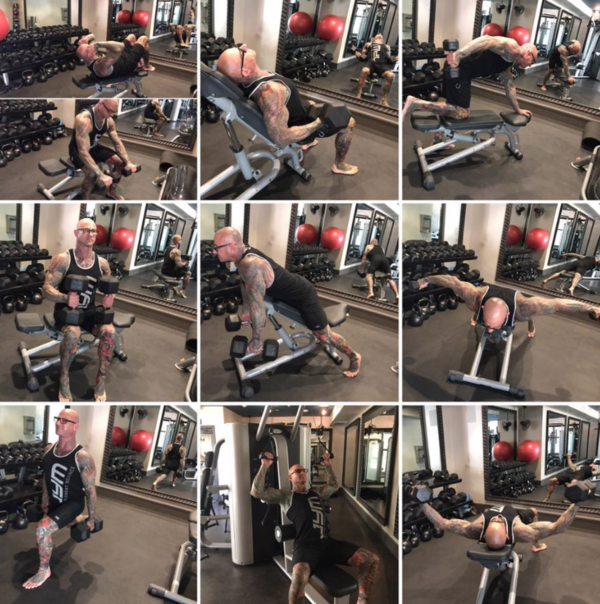
Circuit 3 photos:
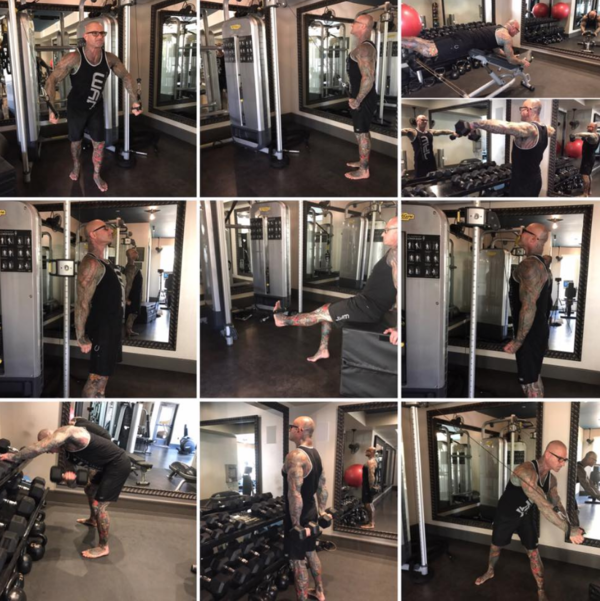
I call this my DeLorme Circuit workout. The DeLorme technique is a popular ascending pyramid. The technique is based around the 10-rep max for each exercise.
You essentially do 3 sets per exercise. Set 1 is a warm-up set done with 50% of your 10-rep max for 10 reps, where you stop way short of muscle failure. Set 2 is another warm-up done with 75% of your 10-rep max for 10 reps. Again, this set falls short of muscle failure. Set 3 is the one and only true working set done to failure. Here, you do your 10-rep max for as many reps as you can until you hit failure. Ideally, that should be at least 10 reps.
That's a standard DeLorme. But leave it to me to Stoppani-up the technique with my full-body version.
My DeLorme Circuit technique has you do Circuit 1 using 50% of your 10-rep max, just like in the original. But, unlike the original, my version doesn't stop at 10 reps. No, you go until you hit muscle failure; so this is both a warm-up set AND a working set. You get 9 exercises worth of rest before you have to come back and do it again.
In Circuit 2, you'll use 75% of your 10-rep max, like the original. But again, unlike the original, you won't stop at 10 reps; you'll take it to muscle failure.
Then, on Circuit 3, we finally get to our true 10-rep max weight. Here, you'll take it to muscle failure, and then you'll immediately drop to the 75% weight and take that to failure. Then, you'll drop to the 50% weight used in Circuit 1 and go to failure again. So you end the third and final circuit with two drop sets.
Ideally, you'll want to stick with the same exercises on each of the 3 circuits. But if the gym is too busy, don't worry about keeping the exercises the same for each muscle group. I did this workout in the dual cable station so that I wouldn't lose my spot and could do all 10 exercises without moving stations. Plus, this is a workout using very light weight. The lowest your reps should get is around 10, and in Circuit 1 you may be as high as 30 reps.
Single-joint moves will work well here, but so will any movements. Choose any exercise you like for the 10 major muscle groups we hit: chest, back, legs, shoulders, traps, calves, triceps, biceps, forearms, and abs.
That's all seven workouts in my Circuit Maximus full-body program. Hope you enjoyed all seven!
Related Articles